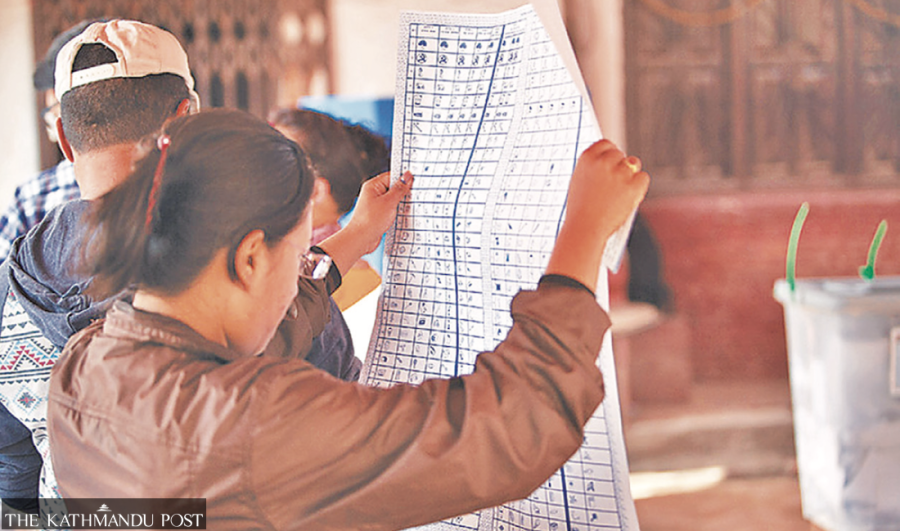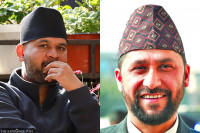Politics
Opposition red over plans to print poll symbols in green
Observers say parties should focus on manifestos rather than squabble over ballot colour.
Binod Ghimire
The Election Commission’s decision to use green election symbols on the ballot papers for the local elections slated for May 13 has made KP Sharma Oli, chair of the main opposition CPN-UML, see red. Taking umbrage at the Election Commission’s decision, Oli recently lashed out at the governing Nepali Congress, whose election symbol is the tree, which is green.
Addressing a function organised by the All Nepal Women Association on Tuesday, Oli said the decision to make the electoral symbols green was intended at favouring the Nepali Congress.
“Is green colour being used to ensure that those with poor vision can see just the tree?” said Oli. “The Election Commission is making efforts to give life to the old tree (Congress). This is unacceptable.”
The Congress reacted.
Talking to the media persons at the party headquarters on Wednesday, Congress spokesperson Prakash Sharan Mahat said, “Shall we chop down trees because the forest is green?”
Congress General Secretary Bishwa Prakash Sharma said Oli’s comments stemmed from the fear of losing [the elections]. “What would happen to those who fear the colour of the ballot paper when they actually see the election results,” said Sharma.
Nepal’s political parties and politicians have a long history of engaging in mudslinging, and when elections approach this practice reaches new heights.
Observers say political parties should focus more on agenda and manifestos and pitch practical and deliverable ideas rather than indulging in pulling each other down. This is just the start, when elections are near, politicians will rely more on mudslinging instead of arguments, according to them.
The verbal fight started after the Election Commission on Monday decided to use green, which it described as SK-3081 Spectrum Bright Green, electoral symbols.
Amid accusations from the leader of the main opposition and counter-arguments from the Congress, the poll body has come forward to defend its decision.
It has said the decision was taken after consulting officials mobilised during the previous elections.
“We decided to have green election symbols on a white sheet of paper as the colour of the ink of the stamp used for casting the ballot will be blue. This will create a proper contrast,” Shaligram Sharma Poudel, a spokesperson for the commission, told the Post. “It will not not only make it easier for voters to cast their votes but also be helpful while counting the ballots.”
The Election Commission had used blue ink for both the stamps and election symbols in the local polls last time which, commission officials say, caused problems while counting.
Commission officials termed the current accusations and counter-accusations nothing but a storm in a teacup.
According to Poudel, green electoral symbols were used in the House of Representatives elections in 2017 as well so the decision is not new.
The commission has also made it clear that it is its jurisdiction what kind of ballot papers are used in elections. Officials say the commission’s sole objective is to conduct a successful election in a free and fair manner, and making it easier for voters to cast their votes and making the counting convenient are part of making the elections a success.
Even though many countries have adopted voting machines, Nepal continues to follow traditional ballot papers during elections. Ballot papers are considered a reliable method but until they are used, chances of accusations like rigging cannot be ruled out. In 2013, when the Communist Party of Nepal (Maoist Centre) lost the second Constituent Assembly elections, the party alleged that there was rigging.
A controversy had arisen in Bharatpur mayoral election when the cadres of the CPN (Maoist Centre) tore the ballot papers after Renu Dahal, the party’s mayoral candidate trailed in the count.
Using paper ballots in elections also increases the chances of invalid votes, especially when there is a lack of voter education.
The current controversy over the colour of the election symbol between the two key political parties of the country—others have not said anything of the commission decision—is indicative of how Nepali politicians lack the agenda.
Observers say the main opposition is making a mountain out of molehill by blowing the colour of the electoral symbol out of proportion. According to them, there are so many issues for the parties, including the UML, to take up when the country goes to polls in May.
“Another colour might match the electoral symbol of another party,” Bhojraj Pokharel, a former chief election commissioner, told the Post. “There are many issues related to development, inflation, people and their livelihoods. But the parties are wasting their breath and time in debating such issues.”
The upcoming local polls will be the second since the country became a federal republic, which held its last local elections in 2017 after 20 years.
As many as 35,014 local representatives for the 753 local units will be elected from the May 13 elections.
The commission on Thursday also said that the only motive behind using the green symbols on white ballot papers is for distinction. “The commission is ready to clarify the issue to any party if there is any confusion,” said Surya Aryal, deputy spokesperson for the commission at a regular press meet.
Experts say as Nepal is on its path to strengthen federalism, which needs empowering local governments, it is incumbent upon the political parties to play constructive and creative roles.
“If parties are squabbling over which colour of election symbol is being used on ballot papers,” said Pokhrel, “this shows they are not interested in talking about the real issue.”
Political experts say local governments are the ones that are directly in touch with day-to-day affairs of the people.
As elections are being held, the parties should be talking about if Singhadurbar, the central secretariat, has actually reached the doorsteps of the people.
“The parties that can really connect with the people are the victors,” Meena Vaidya Malla, a former professor of political science at Tribhuvan University, told the Post. “The colour issue makes no sense. If there are still concerns, that could be resolved through discussions with the Election Commission. It doesn’t deserve a public debate.”




 16.12°C Kathmandu
16.12°C Kathmandu


.jpg&w=200&height=120)












